Now & New
- Eat
Self-Defense Force Curry Rally: Cruising Around Kure’s Curry Joints
It’s not just the Kure locals who know Kaiji Curry to be the pride and joy of their city, but curry lovers nationwide are aware of the delectable concoction that originated from this former naval base. Just to provide a brief explanation, Kaiji Curry is a certain recipe of Japanese-style curry initially served to sailors of the Imperial Japanese Navy (IJN) and subsequently served to the members of the Japan Maritime Self-Defense Force (JMSDF), the successor to the IJN. Since sailors and submariners may spend days at sea or underwater and aren’t allowed to have smartphones or watches on them, they eventually lose track of time and the days of the week. Thus, mealtimes every six hours remind them of the time of day, and serving curry every Friday reminds them what day of the week it is.
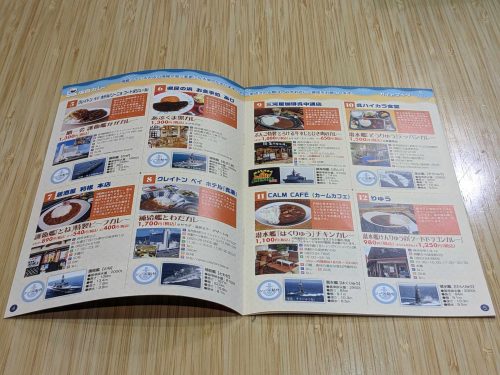
That said, civilians in Kure and all over Japan have had their taste of the renowned Kaiji Curry, and dozens of shops selling the SDF classic have popped up throughout Kure, whether they specialize in curry or simply serve it as one of their myriad dishes. Diners tend to stick to and swear by their favorite curry joints, but since there are always other good restaurants worth knowing, the city of Kure holds a Curry Sticker Rally every year to promote Kaiji Curry establishments all over the city center. Customers who order a participating restaurant’s specialty item listed in the guidebook will receive a sticker from that restaurant to place in the corresponding space. This method entices collectors and completionists to hit up as many valid eateries as they can to complete the rally for the year, as well as to collect the stickers from their favorite restaurants, which may change over time. On this episode, I’ll be participating in the Kaiji Curry Rally too to warm my insides with hot curry in the winter and hopefully discover some new favorite eateries to frequent.
Fleeting Flavors
The first participating restaurant I visited during my challenge was an izakaya called Tone (pronounced “TOE-nay”), which is just a short walk east of Naka-dori, Kure’s central shopping arcade. It’s an izakaya first and a curry shop second, so like many izakaya in Japan, Tone is only open in the evening for dinner, but I was determined to drop by when the clock struck 5:00 p.m. When I was first flipping through the pages of the Kaiji Curry Rally guidebook, I was at a loss as to where to eat first (every picture in the booklet looked so tantalizing), but I ultimately based my first decision on a maritime anime I watched called Kantai Collection (艦隊コレクション – “Ship Fleet Collection), or Kancolle for short. The premise of Kancolle is the personifications of historical battleships as young girls and women sailing on the high seas and combatting abyssal creatures from the deep. The Japanese heavy cruiser Tone also appears in this anime, and though the izakaya’s name reminded me of her, I wasn’t expecting a tribute to the show in what looked to be a Showa era-themed establishment.

The restaurant interior was unabashedly nostalgic, with every inch of the walls and counter space decorated with Showa era memorabilia. The minute I was seated at the counter, I immediately scanned the menu for their Kaiji Curry and inquired about it. It didn’t take too long for the staff to serve me a plate of curry, which came with a side salad and some red Japanese pickles (a staple garnish with Japanese curry). The curry looked impressive with a tiny flag bearing Tone’s name impaled into the knoll of rice, and the roux seemed to go heavy on the chopped onions. However, after digging in, I realized that the flavor was mediocre and even a bit cold, though that may be due to me spending too much time on photography. The salad and pickles came in handy helping me to finish the curry and rice, because I needed all the different flavors I could get to get through.
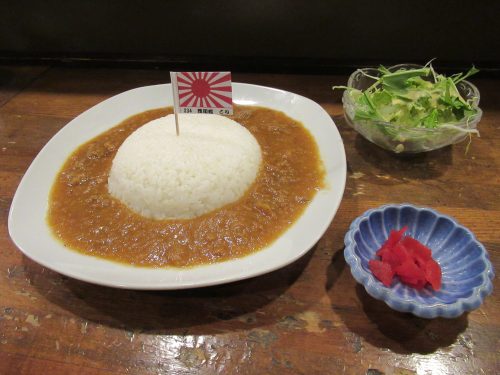
Moment of Joy: Changing My Tone
In spite of all that, I must give credit where credit is due, since Tone is an izakaya after all, with a ton of other awesome food and drink items on its menu. In addition, there actually was the character Tone from Kancolle in the form of a cardboard cutout, which I photographed after finishing my food. Being able to take this picture of Tone was reason enough for me to enter this establishment, but the attentive service and charming restaurant interior also warrant another visit. Next time, though, I’ll be sure to order something besides Kaiji Curry, but Kure has local specialties to spare so that won’t be an issue.
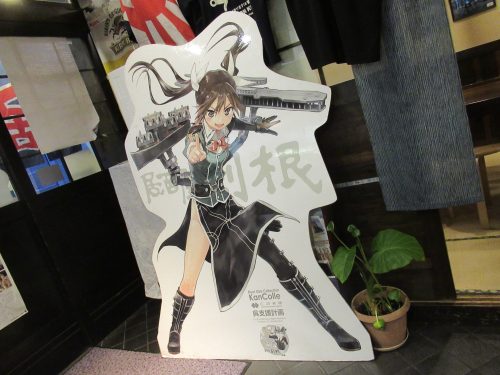
The Mothership of Curry Restaurants
Rally or not, no tour of Kure Kaiji Curry would be complete without dining at the High Collar Mess Hall, so on a different day, I stopped by this restaurant for lunch following a visit to the Yamato Museum. As expected, there was quite a long wait to get in, as every hungry visitor to Kure knows that this place is simply too good to ignore. Consequently, some of the more popular items tend to sell out earlier, so visitors who want to eat a certain something would do well to have lunch as early as possible to avoid disappointment.
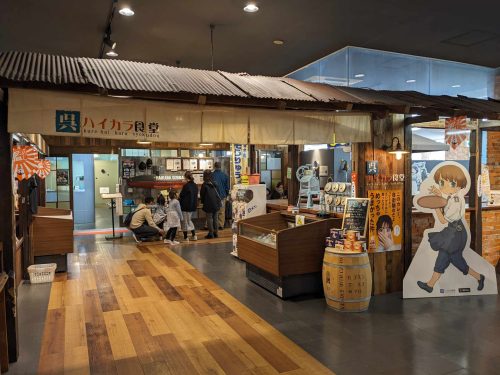
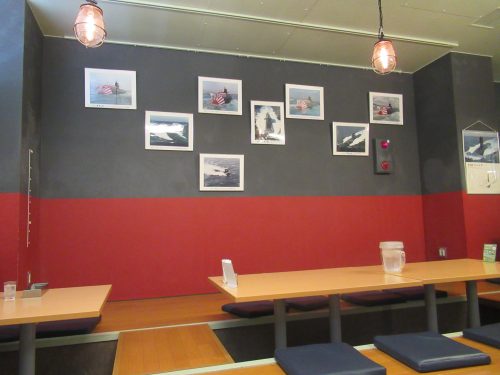
The restaurant is based off of a Soryu-class submarine, so the dining space inside is chock full of pictures of submarines and the servers dress like submarine crew as well. For maximum authenticity, I decided to get a curry lunch set served on a metal tray, just like how real JMSDF submariners would eat it. I had eaten Kaiji curry at this place before, but it was my first time having something as cool as the spread below.
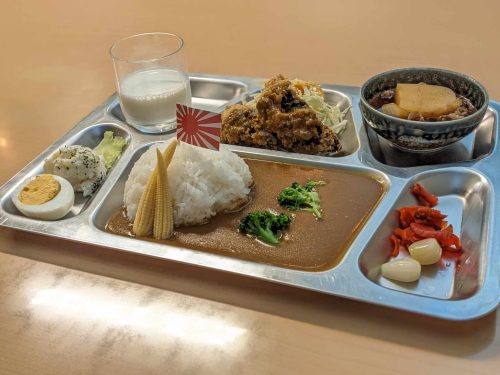
Clockwise from the bottom, I had a mound of steamed rice in a pool of Soryu curry garnished with baby corn and broccoli, half a hard-boiled egg, one scoop of potato salad, a random lettuce leaf, a glass of milk, fried whale cutlets with shredded cabbage, some nikujaga (stewed beef and potatoes), and some pickled veggies to pair with the rice. The last time I had fried whale was about three years ago at this very same establishment, and though I was used to it, I think it tasted better when I was having it for the first time. On the other hand, I was pleased with the nikujaga and the curry roux, the latter of which had a spice level atypical of Japanese curry (it’s normally not spicy enough for me).
Fancy Hotel Curries
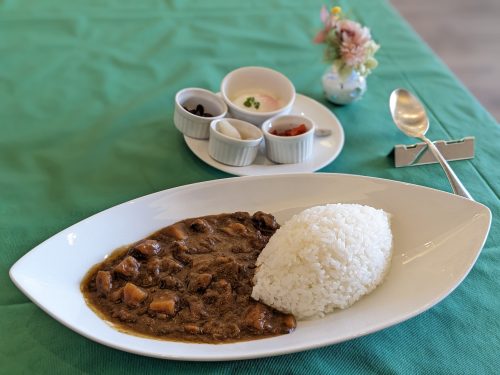
Of course, not every participating restaurant is as humble as the ones I have mentioned so far, for fancy restaurants located inside even fancier hotels are also capable of churning out their own versions of this nostalgic naval recipe. The first such establishment I had the pleasure of having lunch at was Il Mare (Italian for “the sea”), located inside the Kure Hankyu Hotel, itself in the vicinity of Kure Station. I was blown away by this restaurant before I even ordered my food, as the table setting and service were top-notch, just like the staff in the hotel lobby. Then the curry (pictured above) reached my table and I was even more pleased by the richness of the roux as well as the toppings on the side. I was able to enjoy my curry with pickled radish, pickled Chinese onion, a soft-boiled egg, and even raisins (an odd choice of topping, but surprisingly tasty). Since I was there on a Sunday afternoon, it was pretty crowded for lunch, yet they still managed to bring me my food lickety-split so I was a happy camper.
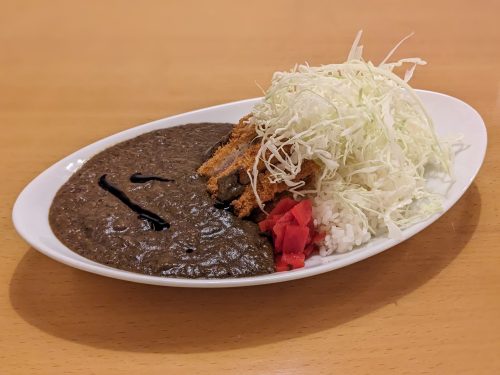
Up next was an equally fancy place at the Clayton Bay Hotel called Sogno Côte d’Azur (“sogno” Italian for “dream,” and Côte d’Azur is the French name for the French Riviera). They had multiple Kaiji Curry options on their menu, but I chose one named after the aircraft carrier Kaga because, surprise, surprise, she is also a character in the Kancolle anime. This beef curry was stewed in chicken stock and fragrant vegetables before being served alongside rice and accompanied by some slices of fried pork cutlet, Japanese pickles, and a blanket of shredded cabbage that eliminated the need for a side salad. What’s more, because I dropped in close to closing time for an early dinner, I soon became the sole diner in the restaurant, and that serene solitude made my experience all the more enjoyable.
Honorable Mention: JMSDF Museum Café

This eatery technically shouldn’t count since it’s not listed in the Kaiji Curry Rally guidebook that the restaurant doesn’t have a sticker associated with it, but anyone on a curry hunt in Kure simply must try the Akishio Curry inside the JMSDF Museum, a tourist site that is impossible to miss. This museum is the only one I know of that lets visitors tour a decommissioned submarine (which is attached to the building), and since admission is free, the JMSDF Museum heavily pushes sales in its gift shop and café, specifically the Akishio Curry, of which only 30 per day are made.
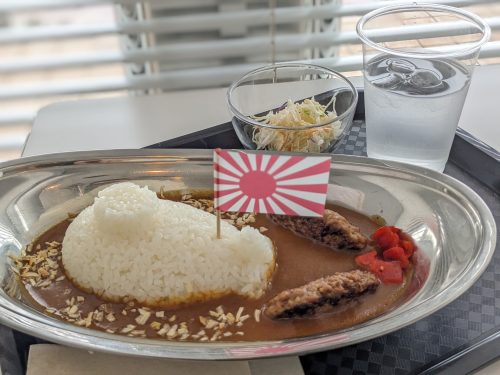
The rice is molded into the shape of an Akishio submarine, the same as the one that visitors can tour inside the museum. That rice submarine seems to submerge from a sea of sweet and spicy curry, topped with a JMSDF toothpick flag and paired with some Hamburg steak, Japanese pickles, and a side salad. Plating like this allows the diner to play with his or her food before eating, though the rice submarine was a bit hard to mash with my spoon even when doused with curry.
While I’m at it, I might as well mention the contents of the museum attached to this café, which you’ll probably see before eating. I repeat, this museum is free to explore every day that it’s open, but on JMSDF Day, which is the 26th of April, the facility also opens up its rooftop terrace, from where tourists get a rare view of the Akishio submarine’s top deck and a magnificent view of Kure harbor. Sadly, it’s not possible to take the Akishio Curry from the café to the top, but guests can still consume their own snacks and drinks up there.
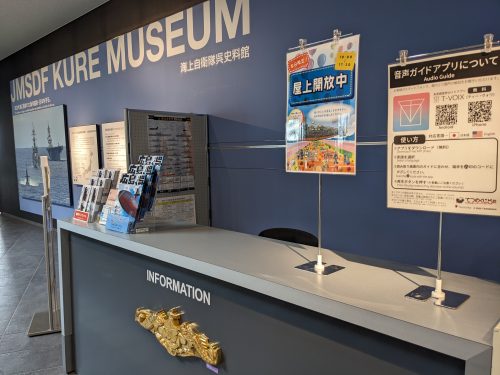
The contents of the museum seem to never change for the most part, covering the JMSDF’s post-war minesweeping missions in the mid- to late 20th century, the technological capabilities of JMSDF submarines, life as a submariner, and the various chambers inside one level of the decommissioned Akishio vessel. However, on the second floor was a special exhibition titled “JMSDF and Overseas Relations,” which featured pictures and video footage of the JMSDF International Review of 2022, in which the ships and aircraft of numerous nations paraded alongside Japanese boats and planes as a sign of international military co-operation. Special exhibitions like this one are key to keeping this free museum from becoming stale, and just might incentivize more tourists into stopping by and consequently trying the beloved Akishio Curry.
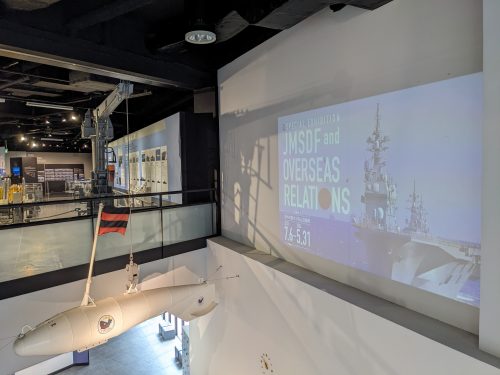
By the end of the Kaiji Curry Rally, I managed to eat at five participating restaurants (the fifth one will be featured in a different article), each with a distinct arrangement of an old-time classic. While not every curry I had would end up my favorite, the Kaiji Curry Rally does its job of spurring curry fans to expand their horizons and discover new joints. Furthermore, diners gain insight on Japanese naval history through the monikers of different restaurants’ curries, all of which are based on past or present Japanese ships. Though there may be twenty-something places in the guidebook (one of them is a vending machine!), the Kaiji Curry Rally really can be done over the course of a year without getting sick of curry and rice. I for one will be dividing my visits to all the participating restaurants over several years to justify constant return trips to the quaint port city. Whether you cruise full speed ahead or chug leisurely though the bay of curry establishments, make sure to make Kaiji Curry at least one of your meals down in Kure!
Written by the Joy in Hiroshima Team
